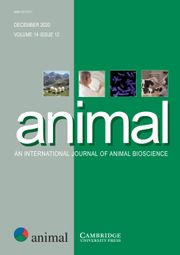Article contents
Characteristics of biter and victim piglets apparent before a tail-biting outbreak
Published online by Cambridge University Press: 01 December 2010
Abstract
Little is known about the characteristics of biters and victims before the appearance of a tail-biting outbreak in groups of pigs. This study aimed to characterise biters and victims (according to gender and performance) and to quantify their behavioural development during the 6 days preceding the tail-biting outbreak. The hypotheses tested were: (a) biters are more often female, are the lighter pigs in the group, are more restless and perform more aggressive behaviour; and (b) victims are more often male, heavier and less active. Using video recordings we carried out a detailed study of 14 pens with a tail-biting outbreak among the weaned piglets. All piglets were individually marked and we observed the behaviour of biters, victims and control piglets (piglet types). In every pen, each piglet type was observed every other day from 6 days before (D−6) to the day of the first visible tail damage (i.e. day of tail biting outbreak; D0). While the number of male biters (6 of the 14 biters) and male victims (11 of the 14 victims) was not significantly different (P = 0.13), this numerical contrast was considerable. The start weight of victims was significantly (P = 0.03) higher (8.6 kg) than those of biters (7.5 kg) and control piglets (8.0 kg). Biters tended (P = 0.08) to spend longer sitting/kneeling (3.1 min/h) than controls (1.7 min/h), but no differences were seen in the time spent lying or standing. Victims tended (P = 0.07) to change posture more often (restlessness) than controls and chased penmates more (P = 0.04) than biters. Victims also performed more (P = 0.04) aggressive behaviour than biters and controls. In contrast, biters tended (P = 0.08) to be chased by penmates more often and tended (P = 0.06) to receive more aggressive behaviour than controls. Furthermore, biters spent longer manipulating the enrichment device (P = 0.01) and the posterior/tail (P = 0.02) of their penmates than controls and tended (P = 0.06) to perform more tail bites than victims. Victims received more posterior/tail manipulation (P = 0.02) and tail bites (P = 0.04) than controls. It was also noticed that, independent of piglet type, restlessness (P = 0.03) increased and the frequency of performed tail bites tended (P = 0.08) to increase in the 6 days preceding a tail-biting outbreak. These findings may contribute to the early identification of biters or victims and support the development of strategies to minimise the occurrence of tail biting.
Information
- Type
- Full Paper
- Information
- Copyright
- Copyright © The Animal Consortium 2010
References
- 72
- Cited by

